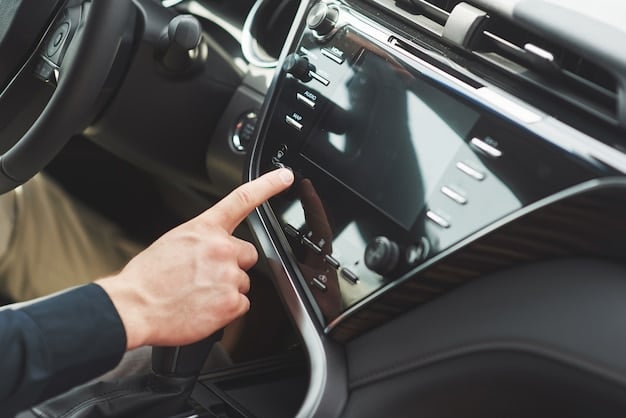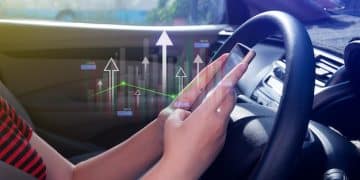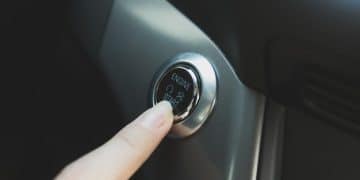Gesture Control in Cars: Gimmick or Genuine Safety?

Gesture control in cars offers a hands-free way to manage vehicle functions, aiming to enhance safety and convenience, but its practicality and reliability are debated, questioning if it’s a valuable feature or just a marketing gimmick.
Is gesture control in cars a futuristic safety innovation or just another overhyped gimmick? Automakers have introduced this technology, promising a hands-free experience that minimizes distractions while driving. But does it truly deliver on its promise, or is it more of a novelty that adds complexity without significant benefit?
Understanding Gesture Control in Cars
Gesture control in cars aims to revolutionize how drivers interact with their vehicles. This technology uses sensors and cameras to interpret hand movements, allowing drivers to control various functions without physically touching buttons or screens. But how does it work, and what are the core components?
How Gesture Control Works
Gesture control systems typically employ infrared cameras or sensors mounted in the car’s interior. These sensors track the driver’s hand movements and recognize pre-defined gestures. Once a gesture is recognized, the system executes the corresponding function.
Key Components of Gesture Control Systems
The main components include sensors, cameras, and software algorithms that process the captured data. The software is programmed to recognize specific gestures and translate them into commands. These commands are then sent to the car’s infotainment system or other relevant control units.
- Sensors and Cameras: Capture hand movements and depth information.
- Processing Unit: Analyzes the data and recognizes gestures.
- Software Algorithms: Translate gestures into specific commands.
- Infotainment System: Executes the commands and provides feedback.
Despite the promise of convenience, the reliability of gesture control often depends on lighting conditions and the clarity of the sensor readings. Inconsistent performance can lead to driver frustration and questions about its true value.

The Promise of Enhanced Safety
One of the main arguments in favor of gesture control is its potential to enhance driving safety. By allowing drivers to keep their hands on the wheel and eyes on the road, gesture control aims to reduce distractions and prevent accidents. But how well does it achieve this goal?
Reducing Driver Distractions
Gesture control offers a hands-free alternative to traditional controls, minimizing the need for drivers to look away from the road. This can be particularly useful for tasks like adjusting the volume, answering calls, or navigating through menus.
Maintaining Focus on the Road
By keeping hands on the wheel, drivers can maintain better control of the car. This is especially important in challenging driving conditions, where quick reactions are necessary. However, the effectiveness of gesture control in reducing distractions depends on its accuracy and ease of use.
- Hands-Free Operation: Reduces the need to physically interact with controls.
- Eyes on the Road: Minimizes visual distractions for enhanced safety.
- Quicker Reactions: Allows drivers to maintain better control in critical situations.
While gesture control may sound promising, real-world effectiveness can vary. The technology’s sensitivity and responsiveness play a crucial role in whether it truly contributes to safety or becomes another source of distraction.
Convenience and the User Experience
Beyond safety, gesture control aims to provide a more convenient and intuitive user experience. The idea is to simplify interactions with the car’s systems, making them more accessible and enjoyable. But does it live up to these expectations?
Simplifying Car-Driver Interactions
Gesture control can streamline common tasks such as adjusting the climate control, changing radio stations, or setting a navigation destination. By using simple hand movements, drivers can perform these actions without complicated menus or physical controls.
Intuitive and Enjoyable Features
Many drivers find gesture control to be a novel and engaging feature. The ability to control the car with a wave of the hand can add a touch of futurism to the driving experience. However, the long-term appeal of gesture control depends on its reliability and practicality.
- Easy Access: Streamlines common tasks with simple gestures.
- Futuristic Appeal: Adds a high-tech, modern feel to the car.
- Enhanced Comfort: Allows drivers to adjust settings without physical strain.
Despite the potential for convenience, usability issues can detract from the overall experience. If gestures are not recognized consistently or require overly precise movements, drivers may become frustrated and abandon the feature altogether.
The Gimmick Argument: Is It Necessary?
Critics of gesture control argue that it is an unnecessary gimmick that adds complexity without providing significant benefits. They question whether the technology offers a genuine improvement over traditional controls or if it’s simply a marketing ploy to attract tech-savvy consumers. So, where’s the evidence?
Evaluating the Practical Benefits
One common criticism is that gesture control solves a problem that doesn’t really exist. Many argue that traditional buttons, knobs, and touchscreens are perfectly adequate for controlling vehicle functions. Some studies suggest that drivers are already comfortable with these existing methods.
Comparing Gesture Control to Traditional Controls
Traditional controls are often more reliable and predictable than gesture control. Buttons and knobs provide tactile feedback, allowing drivers to operate them without looking. Touchscreens, while sometimes distracting, are also widely used and understood.
The debate centers on whether the added complexity of gesture control justifies its limited benefits. If the technology is not significantly better than existing options, it may be seen as an unnecessary expense and a potential source of frustration.
Potential Drawbacks and Limitations
While gesture control has its proponents, it also has several potential drawbacks and limitations. These issues range from technical challenges to user experience problems. Understanding these limitations is crucial for evaluating the true value of the technology.
Technical Challenges and Reliability Issues
Gesture control systems can be affected by various factors, including lighting conditions, clothing, and even the driver’s physical characteristics. Poor lighting or bulky clothing can interfere with the sensors, leading to inaccurate readings. Inconsistent performance can erode driver confidence in the system.
User Experience Problems
Many users find gesture control to be less intuitive than traditional controls. Learning and remembering the correct gestures can take time and effort. The system may also misinterpret gestures, leading to unintended actions and frustration.

- Environmental Factors: Lighting and obstructions can hinder performance.
- Learning Curve: Requires time and effort to master gestures.
- Misinterpretations: Can lead to unintended actions and frustration.
These limitations raise questions about the overall practicality and user-friendliness of gesture control. If the technology is not reliable and easy to use, it may fail to gain widespread acceptance.
The Future of Gesture Control
Despite its current limitations, gesture control has the potential to evolve and improve over time. Advances in sensor technology, artificial intelligence, and user interface design could address many of the existing drawbacks. What could this look like in the car industry?
Advancements in Sensor Technology
New sensor technologies, such as enhanced infrared cameras and 3D sensors, could improve the accuracy and reliability of gesture recognition. These advancements could make gesture control more robust and less susceptible to environmental factors.
Integration with Artificial Intelligence
AI could play a crucial role in enhancing gesture control systems. By learning from user behavior and adapting to individual preferences, AI could make the technology more intuitive and personalized. AI could also help the system differentiate between intentional gestures and accidental movements.
Ultimately, the future of gesture control depends on overcoming its current limitations and demonstrating its value to drivers. If automakers can create systems that are reliable, intuitive, and genuinely useful, gesture control could become a mainstream feature in future vehicles.
| Key Point | Brief Description |
|---|---|
| 🚗 Safety Enhancement | Reduces distractions by allowing hands-free control. |
| 👍 User Convenience | Simplifies in-car interactions with easy hand gestures. |
| ⚙️ Technological Limitations | Affected by lighting and clothing; gestures may be misinterpreted. |
| 🔮 Future Potential | AI and sensor advancements could enhance reliability and usability. |
FAQ
▼
Gesture control in cars allows drivers to manage vehicle functions like volume and climate using hand movements instead of buttons or touchscreens, enhancing convenience and safety.
▼
By enabling hands-free operation, gesture control reduces the need for drivers to take their eyes off the road, minimizing distractions and improving reaction times.
▼
Gesture control can be unreliable due to lighting conditions, clothing, and misinterpretations of gestures, leading to driver frustration and unintended actions.
▼
The ease of use varies; some find it intuitive, while others struggle with the learning curve and remembering specific gestures for different functions in the car.
▼
Future improvements include enhanced sensor technology, AI integration for personalization, and improved gesture recognition to minimize errors and increase reliability.
Conclusion
In conclusion, gesture control in cars presents a mixed bag of potential benefits and limitations. While it promises enhanced safety and convenience through hands-free operation, its reliability and practicality are still under debate. As technology advances, future iterations may address current drawbacks, making gesture control a valuable asset rather than just a fleeting gimmick.





